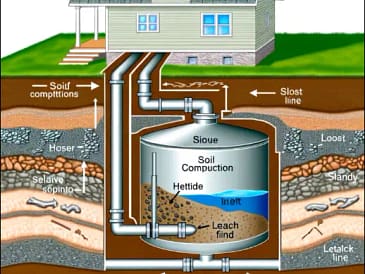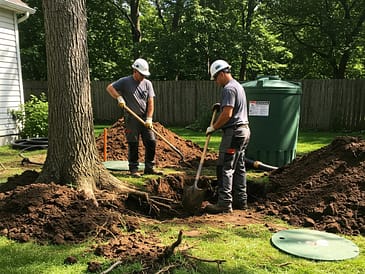Ever wonder where exactly your septic tank is buried in your yard?
You’re not alone.
Thousands of homeowners are unaware of where their system lies until a backup floods their bathroom or a renovation project hits a pipe.
Knowing the location of your septic tank isn’t just helpful—it can save you thousands in repairs and keep your property safe and functional for years to come.
Why Knowing Your Septic Tank Location Matters
Understanding where your septic tank is located is crucial for routine maintenance, emergency repairs, and avoiding costly mistakes during landscaping or construction. Many homeowners search for their septic system after noticing drainage issues or when preparing to sell their home. Proper documentation of your system prevents unnecessary excavation and ensures service professionals can quickly assess any problem.
When you locate and map your septic system, you empower yourself to handle emergencies swiftly. You also reduce the risk of property damage and environmental contamination. Most importantly, this knowledge gives you long-term peace of mind as a homeowner.
Understanding Your Septic System
A residential septic system typically includes the main sewer line, the septic tank, distribution boxes, and the drainfield. Wastewater exits your home through the main line, settles in the tank where solids sink and scum floats, and trickles through perforated pipes into the drainfield for natural filtration into the soil.
Your tank is usually buried several feet underground, and finding it requires knowing what to look for. Common surface indicators include slightly raised or sunken ground, rectangular patches of greener grass, or a subtle odor. These visual cues can point you in the right direction—but they’re only part of the puzzle.
Step-by-Step Guide to Finding Your Septic Tank
Step 1: Check Property Records
Start your search by reviewing the original property records or septic system permits. Local health departments or county offices typically keep these documents. Request the “as-built” drawings, which are diagrams created after the system was installed. These often feature precise measurements from your house to the tank location.
Old maintenance reports or inspection logs may also contain helpful clues. Look for notations about tank depth, access lid positioning, and setbacks from your home or property lines.
Step 2: Identify Plumbing Clean-Out Points
Locate your main plumbing clean-outs. Indoors, they’re often found in basements or crawlspaces and resemble capped white PVC pipes. Outside, they may look like small capped pipes sticking out of the ground near your home’s foundation. By identifying where your waste line exits the house, you can estimate the tank’s direction and distance.
Follow a straight line from this point, as septic tanks are usually installed 10 to 25 feet from the home in the direction of the pipe outlet.
Step 3: Look for Yard Clues
Scan your yard carefully. The area above a septic tank may be covered with gravel or show signs of past disturbance. Depressions, mounds, or darker green grass indicate areas with excess moisture—common around septic systems.
These low-tech signs can help narrow your search before you use more advanced methods.
Step 4: Probe for the Tank
Using a soil probe or strong metal rod, gently prod the ground in the suspect area. Avoid using excessive force to prevent damaging pipes or the tank’s surface. When you feel resistance or hear a hollow sound, you’ve likely hit a part of the tank or a lid.
Carefully mark the edges you identify. You can map the outline of the tank by probing and marking each corner over time.
Step 5: Use High-Tech Tools or Hire a Pro
If manual methods fail, consider using septic locating tools like flushable transmitters or electronic pipe locators. These tools can track the tank’s location from inside the pipe system without the need for excavation.
When in doubt, hire a licensed septic professional. As per the National Onsite Wastewater Recycling Association (NOWRA), “Trained inspectors can locate your system with minimal disturbance and ensure everything functions as designed.” It’s a small investment that can save major hassle.
How to Create a Septic System Property Map
Why a Map Is Important
A septic system map is invaluable for future repairs, real estate appraisals, and system upgrades. It eliminates guesswork for service providers, and many counties require property diagrams during home sales or permit applications.
Mapping Materials and Tools
Grab a measuring tape, graph paper or digital mapping tool, stakes, and markers. You can also use apps like Home Design 3D or graphing software to create a digital version. Alternatively, simple hand-drawn lines with accurate measurements do the trick.
Recording Accurate Measurements
Measure distances from major landmarks—corners of your house, fences, deck posts, or permanent landscaping features. Note the tank location, pipe directions, and drainfield in feet and inches from these reference points. Your map should be to scale as much as possible for clarity.
Label all components: the tank, clean-outs, distribution box, access lids, and drainfield trenches. Don’t forget to indicate any vent pipes or risers visible on the lawn.
Store Your Map
Make both physical and digital copies of your property map. Keep one copy with your home improvement records and another with your septic service provider. Back up the file in cloud storage or email it to yourself for easy access when emergencies arise.
Common Mistakes to Avoid
Never dig blindly. Striking your septic tank or a utility line can cause contamination, personal injury, or hefty repair bills. Always confirm with local utility locator services before digging.
Avoid relying on hearsay or assumptions about where the tank “should be.” Septic systems vary and aren’t always installed in textbook fashion—especially on older properties or DIY installations.
Finally, remember that outdated maps or forgotten renovations can affect your system’s layout. Always update your diagram after repairs or upgrades.
Tips for Ongoing System Maintenance
Regular upkeep starts with access. Keep surfaces above the septic tank free of clutter, decks, and landscaping. Don’t drive or park heavy vehicles over the system.
Schedule inspections every 1 to 3 years and pumping every 3 to 5 years, depending on usage. Proactive care extends your system’s life and prevents nasty surprises.
Always update your property map anytime work is done. Even small changes can impact long-term system accuracy and safety.
Conclusion
Knowing your septic tank’s location isn’t just a nice-to-have—it’s a must for responsible homeownership. From time-saving repairs to smoother real estate transactions, mapping your septic system puts power in your hands.
Take control today. Track down your tank, create a map, and maintain it for years to come. For more in-depth support, check your local health department’s guidelines or seek a certified septic inspector in your area.
“`





